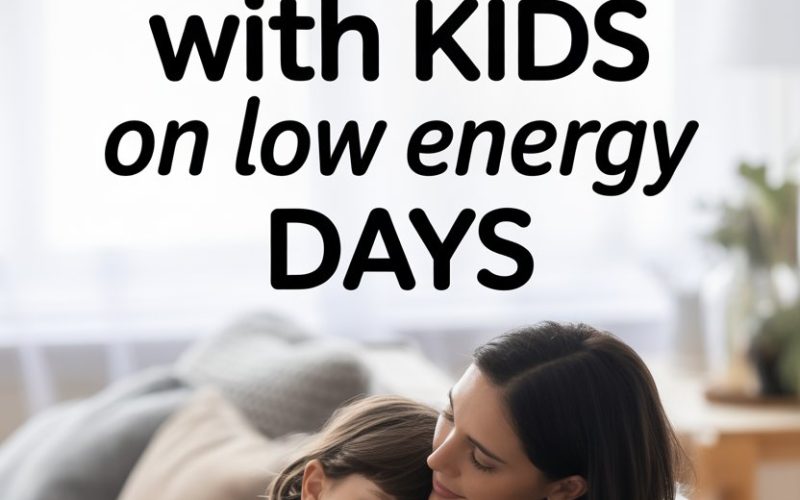Some days, you wake up already tired—was there a secret midnight marathon you weren’t invited to? Cups of coffee multiply but the energy just never shows up. And yet, small humans with very large feelings (and louder voices) still want you present.
Parenting on low battery isn’t an urban myth. It’s Thursday.
Here’s the good news: you don’t need superhero stamina to be a great parent. Warmth, connection, and even a bit of fun can all survive (and thrive) on days when you’d rather become one with the sofa.
Redefining “Quality Time” When You’re Flat Out
Forget Instagram standards. Connection doesn’t always mean crafting an elaborate replica of the solar system or building a fort worthy of an interior design spread. According to child psychologist Dr. Laura Markham, kids thrive on presence, not performance.
Think of it this way: your attention is the main ingredient. That can mean sitting together, sharing a silly thought, or just being still in the same room. Yes, even if you’re both in your pyjamas and the closest thing to an “activity” is passing the remote.
On low energy days, scale back expectations. Quality beats quantity every time.
Lean Into “Parallel Play”
Ever noticed how toddlers play side by side, each in their own little world? Turns out, parallel play isn’t just for the under-fives. When energy is missing in action, embrace togetherness without pressure to constantly interact.
Colour next to each other at the kitchen table. Read your own book while your child doodles or builds with blocks. Even folding laundry becomes an act of connection when you’re both there, sharing space.
Don’t be fooled: this “low-key” togetherness sends strong signals of love and security. In fact, experts say the mere act of sharing space in a relaxed way helps children feel safe and valued.
Television: Friend, Not Foe (Yes, Really)
That’s right—screen time isn’t the villain it’s made out to be. The trick? Watch together, not just side-by-side. Shared viewing transforms a TV show or movie into an experience you both enjoy (or groan about) together.
Ask what they think of the characters. Make guesses about what will happen next. Whisper snarky commentary. When you’re horizontal on the sofa, this counts as high-level connection.
Not sure where to start? Common Sense Media curates family-friendly films and shows guaranteed to spark conversation.
Snuggle Science: The Power of Low-Energy Affection
Nothing beats a cuddle when you’re weary. Turns out, research backs this up. A study published in Harvard Medical School found that even brief physical affection boosts oxytocin, the so-called “connection hormone,” in both parent and child.
Invite your child for a snuggle under a blanket. Hold hands while you both lie in a heap and recount the best (or silliest) parts of the day. Trace their fingers, rub their back, let them play with your hair—anything that says “I love you and I’m here,” even if you’re horizontal.
No need for grand gestures. You’re not auditioning for a sentimental advert.
Dial Down the Chores—Turn Everyday Moments Into Connection
Multitasking is a myth. Still, some days the dishes won’t wash themselves, and dinner won’t appear via magic.
On days when energy is rationed, recruit your kids for low-stakes “together” time. Peel carrots side by side, stack plates into the dishwasher, or fold towels together. The task matters less than the chance to chat—or share a comfortable silence.
Ask silly “would you rather” questions. Share tales from your own childhood. Or just let them ramble about whatever’s on their mind (Minecraft, cheese, the neighbour’s suspicious cat).
The American Academy of Pediatrics reports that these little exchanges build trust and open communication. Bonus: you might actually get something done.
Unleash the Power of “Special Time” (Five Minutes Is Plenty)
“Special Time” sounds like a marketing gimmick, but it’s an evidence-based winner. Give your child five (yes, five) minutes of undistracted, device-free attention doing something they choose. Put on a timer if that helps you both stick to it.
During those moments, let them lead the play or conversation, however simple. Build a lopsided tower, draw squiggly monsters, or invent a handshake. When your energy starts sputtering, let them know you’re looking forward to next time.
Parenting expert Dr. Becky Kennedy swears by this approach. It’s connection in a shot glass, not a pitcher—and it works.
Say “Yes” to Board Games (Even the Short Ones)
Forget Monopoly marathons. Simple, speedy board games or card games can pack a connection punch without draining every last drop of energy.
Go Fish, Uno, Snap—no need to break out the four-hour epic. Even a single round counts. If you’re extra low on pep, let the kids make up new rules or be the “official scorekeeper.” You’re supervising, not sitting an exam.
Losing to a seven-year-old at Guess Who? is practically a rite of passage.
Embrace “Lazy Creativity”
Art doesn’t need to mean glitter explosions and paint on the dog. Provide paper, pencils, stickers, and let your child take the lead. Doodle alongside them, or simply admire their masterpiece-in-progress.
If energy is really scarce, try “drawing challenges”: Who can draw the goofiest monster? Who can draw with their eyes closed? Who can make a picture using only dots? Laughter is the goal, not gallery-worthy results.
A study from Drexel University found that even casual art-making reduces stress and boosts mood. Messy bun, paint-stained fingers, and a happier heart—now that’s a win.
Listen More Than You Talk
Sometimes, the best way to connect is to simply be there, ears open. On tired days, lean into listening. Ask questions, then let your child ramble, even if the subject is “every Pokémon ever, in order.”
Nod, smile, reflect back what you hear (“Sounds like you had a wild day at school!”). You don’t have to fix anything or offer profound wisdom. Being heard is the gift.
According to Harvard’s Center on the Developing Child, active listening is one of the most powerful ways to support kids’ mental health and emotional development.
Invent “Rest Time Together”
This is not a nap (though, wouldn’t that be lovely?). Rest time is when everyone chills out in the same space—books, soft music, maybe an audiobook, all on pillows and blankets. You might call it “quiet hour,” “cosy time,” or “everyone-please-stop-yelling-o’clock”—whatever fits your vibe.
Kids may resist at first (“But I’m not tired!”), but offering a menu of restful options helps: colouring, puzzles, listening to a story, or just flopping about.
Sleep Foundation notes that even short relaxation breaks can recharge both kids and adults, helping everyone reset for the rest of the day.
Shift Your Inner Voice: Connection Comes in Many Shapes
Here’s a hot tip: your child isn’t keeping a spreadsheet of parental output. They remember how you made them feel, not whether you orchestrated a Pinterest-worthy afternoon.
Give yourself permission to lower the bar when you need to. Kids learn resilience and flexibility when they see their grown-ups taking care of themselves, too. Model self-kindness, and that lesson will outlast any craft project or themed snack platter.
Make “Low-Energy Rituals” Part of Family Culture
Every family has those little routines—pancakes on Saturdays, silly handshakes before school, bedtime stories read in funny voices. On the days when you’re worn thin, lean into these rituals. They’re easy, comforting, and do a lot of emotional heavy lifting.
Even a brief nightly “gratitude round” (one thing you each liked about the day, even if it’s “I liked when the cat didn’t sit on my sandwich”) can anchor connection.
Family rituals don’t require fancy props or lots of energy. Just show up, be present, and let the tradition do the rest.
The Secret Superpower: Honest Communication
Some days, you just have to level with your kids. “Mum’s a bit knackered today, I’m afraid. I can’t run around, but I’d love to sit and chat.” You’d be surprised how children rise to the occasion when you share your limits kindly and matter-of-factly.
This teaches empathy, self-awareness, and that grown-ups aren’t robots. Every parent deserves a day (or several) when the best you can offer is yourself—no glitter required.
When Low Energy Is More Than Just “One of Those Days”
If exhaustion becomes the norm, or if you’re struggling to bounce back despite rest, have a chat with your GP or a trusted health professional. Physical health, mental health, and parenting are entwined. You deserve support as much as your kids do.
No shame in asking for help. Besides, nobody gives out medals for powering through on empty. Wouldn’t it be nice if they did, though?





